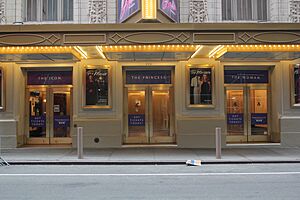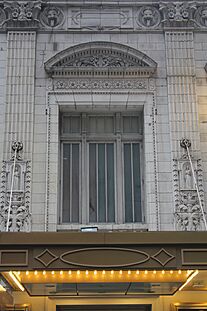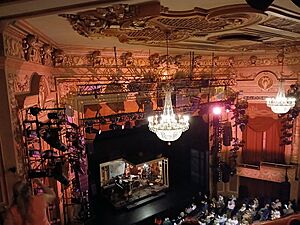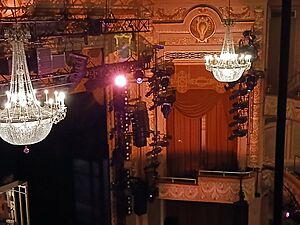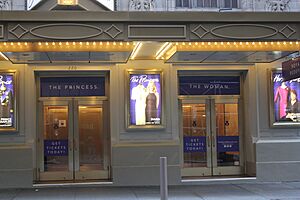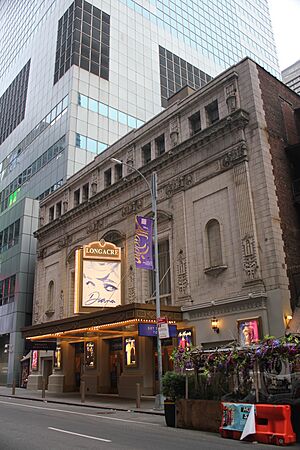Longacre Theatre facts for kids
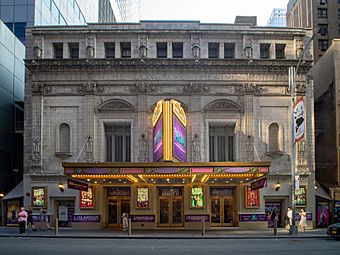
The theater showing The Prom in 2019
|
|
| Address | 220 West 48th Street Manhattan, New York United States |
|---|---|
| Coordinates | 40°45′37″N 73°59′09″W / 40.76028°N 73.98583°W |
| Owner | The Shubert Organization |
| Type | Broadway |
| Capacity | 1,077 |
| Construction | |
| Opened | May 1, 1913 |
| Years active | 1913–1942, 1953–present |
| Architect | Henry Beaumont Herts |
| Designated | December 8, 1987 |
| Reference no. | 1348 |
| Designated entity | Facade |
| Designated | December 8, 1987 |
| Reference no. | 1349 |
| Designated entity | Auditorium interior |
The Longacre Theatre is a famous Broadway theater located at 220 West 48th Street in New York City. It's right in the middle of the busy Theater District in Midtown Manhattan. The theater first opened its doors in 1913.
It was designed by architect Henry B. Herts and is named after Longacre Square, which is the old name for Times Square. The Longacre can seat 1,077 people on three different levels. It is currently operated by The Shubert Organization. Because of its beautiful and historic design, both the outside and inside of the theater are protected as New York City designated landmarks.
Contents
Location and Design
The Longacre Theatre is located on a block with many other famous theaters. Before it was built, the land was home to several three-story houses. The area is now a major center for entertainment.
The Outside of the Theater
The front of the theater, which faces 48th Street, has a classic French style. The ground floor is made of textured terracotta blocks. A large sign, called a marquee, hangs over the main entrance, protecting guests from the weather and showing the name of the current play.
The upper floors are decorated with tall, flat columns called pilasters. Between the columns are niches holding statues of women who represent Drama. The three large windows in the center have curved tops. Originally, large billboards for the shows were hung on the outer sections of the building.
Inside the Theater
The theater was built to be fireproof, using strong materials like stone, brick, and steel. The auditorium, where the audience sits, has a sloped orchestra level, two balconies, and private boxes on the sides. The space is decorated with beautiful plaster designs.
The theater has 1,077 seats. This includes 508 seats in the orchestra, 304 in the first balcony, 249 in the second balcony, and 16 in the boxes. The balconies were designed to be close to the stage, so everyone has a good view. The original colors were gold, purple, and topaz, but a 2008 renovation changed the color scheme to gold and green.
The stage is framed by a large, flat arch called a proscenium. The arch is decorated with detailed patterns of shells and leaves. Above the arch is a decorative shield, or cartouche. The ceiling is also decorated with plasterwork and has two large chandeliers.
In 2008, a new lounge was added in the basement, and the attic was turned into another lounge with a bar and restrooms for theatergoers.
History of the Theater
Times Square became the center of New York's theater world in the early 1900s. Many new theaters were built during this time, including the Longacre.
Building and Early Years
In 1911, a theater producer named Harry Frazee bought the land to build a new theater for his musicals. He hired architect Henry B. Herts to design it. Construction began in 1912.
The Longacre Theatre officially opened on May 1, 1913, with a play called Are You a Crook?. Unfortunately, the play was a "flop," meaning it was not successful and closed quickly. However, the theater soon had a hit with the musical Adele.
In 1917, Frazee sold his share of the theater to focus on his other passion: baseball. He had just bought the Boston Red Sox baseball team. The theater continued to host popular shows, including the musical Leave It to Jane in 1917.
The Shubert Years and Studio Era
In 1924, the famous Shubert brothers bought the Longacre Theatre. They staged many successful plays, including The Butter and Egg Man in 1925 and An American Tragedy in 1926.
During the Great Depression in the 1930s, the theater had a tough time, with many shows closing quickly. One of the few hits was Waiting for Lefty in 1935.
From 1944 to 1953, the Longacre was not used for plays. Instead, it was leased as a radio and television studio for the Mutual Broadcasting System. In 1953, it returned to being a live theater. One of its first big hits after reopening was The Lark in 1955, starring Julie Harris and Boris Karloff.
A Reputation for Flops
In the 1960s and 1970s, the Longacre developed a reputation for hosting shows that were not successful. A 1969 book even called it a "flop theater." This changed in 1975 with the hit comedy The Ritz.
The theater's biggest success came in 1978 with the musical revue Ain't Misbehavin', which celebrated the music of Fats Waller. The show was so popular it ran for 1,604 performances, though it moved to other theaters during its run. Another major hit was Children of a Lesser God in 1980.
In 1987, the Longacre was officially named a New York City landmark, protecting its historic design from being changed.
Recent History and Renovation
In the early 1990s, there was a plan to turn the theater into a courtroom, but many people in the theater community protested. The plan was dropped, and the Longacre remained a theater.
After a period with few hits, the theater was closed in 2007 for a major $12 million renovation. Workers restored the original decorations, put in new seats, and updated the building. The theater reopened in 2008 with the comedy Boeing Boeing, which was a big success.
Since then, the Longacre has hosted many popular shows, including:
- La Cage aux Folles (2010)
- Of Mice and Men (2014)
- A Bronx Tale (2016)
- The Prom (2018)
- Macbeth starring Daniel Craig (2022)
- Leopoldstadt (2022)
The theater closed in March 2020 due to the COVID-19 pandemic but reopened in November 2021. In 2025, the musical Dead Outlaw opened at the Longacre.
See also
- List of Broadway theaters
- List of New York City Designated Landmarks in Manhattan from 14th to 59th Streets


